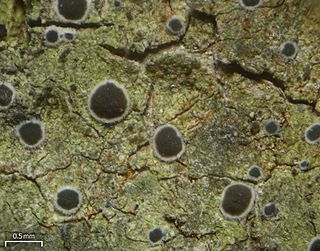
Bacidina is a genus of lichens in the family Ramalinaceae. It was circumscribed by Czech lichenologist Antonín Vězda in 1990, with Bacidina phacodes assigned as the type species. Vězda included 11 species in Bacidina, which was originally classified in the Lecideaceae. These species had previously been placed in genus Bacidia.

The Mycocaliciaceae are a family of seven genera and about 90 species of fungi in the order Mycocaliciales.
Mazaediothecium is a genus of calicioid lichens in the family Pyrenulaceae. It has four species. The genus was circumscribed by Dutch lichenologist André Aptroot in 1991, with Mazaediothecium rubiginosum assigned as the type species.

Byssoloma is a genus of leaf-dwelling lichens in the family Pilocarpaceae.

Lecanactis is a genus of crustose lichens, commonly called old wood rimmed lichen. The genus was circumscribed in 1855 by German lichenologist Gustav Wilhelm Körber, who assigned Lecanactis abietina as the type species.

Anisomeridium is a genus of lichens in the family Monoblastiaceae. The type species was originally named Arthopyrenia xylogena by Swiss botanist Johannes Müller Argoviensis in 1883; in 1928, Maurice Choisy defined the genus Anisomeridium, designating A. xylogena the type species.
Heterocyphelium is a lichen genus in the family Lecanographaceae. It was circumscribed by Finnish lichenologist Edvard August Vainio in 1927, with H. leucampyx assigned as the type species. The genus remained monotypic until a new species, H. triseptatum, was described in 2017 from collections made in Brazil.
Nyungwea is a genus of lichen-forming fungi in the family Opegraphaceae. It was circumscribed in 2006 by Emmanuël Sérusiaux, Eberhard Fischer, and Dorothee Killmann, with Nyungwea pallida assigned as the type species.

Chaenothecopsis is a genus of about 40 species of pin lichens in the family Mycocaliciaceae. Many of the species are resinicolous, meaning they grow on conifer resin or other plant exudates. Most common host plants are trees in the genera Abies, Picea, and Tsuga.
Stenocybe is a genus of fungi in the family Mycocaliciaceae. It has 14 species.
Polymeridium is a genus of fungi in the family Trypetheliaceae. The genus was originally circumscribed as a section of the genus Arthopyrenia by Swiss lichenologist Johannes Müller Argoviensis in 1883. Richard Harris elevated it to generic status in 1980.
Pseudopyrenula is a genus of lichen-forming fungi in the family Trypetheliaceae.
Trypethelium is a genus of lichenized fungi in the family Trypetheliaceae. The widespread genus contains about 50 species that are predominantly found in tropical areas. Trypethelium was circumscribed by German botanist Kurt Polycarp Joachim Sprengel in 1804.
Wegea is a genus of fungi within the order Arthoniales. The genus has not been placed into a family. This is a monotypic genus, containing the single species Wegea tylophorelloides. The genus was circumscribed in 1997 by André Aptroot and Leif Tibell. The species have a morphology similar to calicioid fungi, but does not form a mazaedium.
André Aptroot is a Dutch mycologist and lichenologist.

Malmideaceae is a family of crustose and corticolous lichens in the order Lecanorales. It contains eight genera and about 70 species.
Mycocalicium enterographicola is a species of lichenicolous fungus in the family Mycocaliciaceae. It is found in Brazil.
Phylloblastia is a genus of foliicolous (leaf-dwelling) lichens in the family Verrucariaceae. The genus was circumscribed in 1921 by Finnish lichenologist Edvard August Vainio, with Phylloblastia dolichospora assigned as the type species.

Robert Lücking is a German lichenologist. He is a leading expert on foliicolous lichens–lichens that live on leaves.








